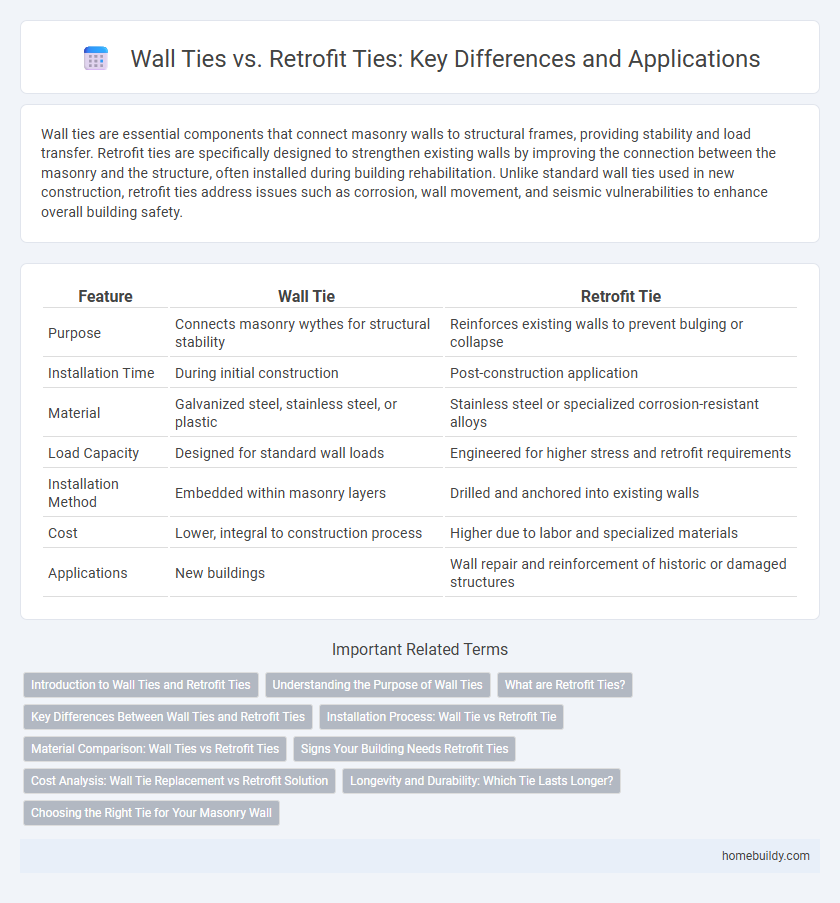Wall ties are essential components that connect masonry walls to structural frames, providing stability and load transfer. Retrofit ties are specifically designed to strengthen existing walls by improving the connection between the masonry and the structure, often installed during building rehabilitation. Unlike standard wall ties used in new construction, retrofit ties address issues such as corrosion, wall movement, and seismic vulnerabilities to enhance overall building safety.
Table of Comparison
| Feature | Wall Tie | Retrofit Tie |
|---|---|---|
| Purpose | Connects masonry wythes for structural stability | Reinforces existing walls to prevent bulging or collapse |
| Installation Time | During initial construction | Post-construction application |
| Material | Galvanized steel, stainless steel, or plastic | Stainless steel or specialized corrosion-resistant alloys |
| Load Capacity | Designed for standard wall loads | Engineered for higher stress and retrofit requirements |
| Installation Method | Embedded within masonry layers | Drilled and anchored into existing walls |
| Cost | Lower, integral to construction process | Higher due to labor and specialized materials |
| Applications | New buildings | Wall repair and reinforcement of historic or damaged structures |
Introduction to Wall Ties and Retrofit Ties
Wall ties serve as critical structural connectors, anchoring external masonry walls to internal framing and enhancing overall building stability. Retrofit ties are specialized devices designed to reinforce existing structures by improving wall integrity and resistance to lateral forces, commonly used in seismic or aging buildings. These ties differ in application and material composition, with wall ties typically integrated during initial construction and retrofit ties added post-construction to address structural vulnerabilities.
Understanding the Purpose of Wall Ties
Wall ties serve to connect the outer brickwork to the inner structural wall, ensuring stability and preventing separation due to lateral forces. Retrofit ties are specifically designed to reinforce existing walls, addressing issues like bowing or bulging by re-establishing a secure connection between wythes. Understanding the purpose of both types helps in selecting the appropriate tie for new construction or repair projects, maintaining structural integrity and safety.
What are Retrofit Ties?
Retrofit ties are specialized wall ties designed to reinforce existing masonry walls by connecting the outer brick veneer to the inner structural wall, enhancing stability and preventing separation. These ties are typically installed in older buildings where original ties have deteriorated or are absent, providing a cost-effective solution for structural reinforcement without extensive reconstruction. Retrofit ties come in various materials such as stainless steel and are engineered to comply with modern building codes for improved durability and corrosion resistance.
Key Differences Between Wall Ties and Retrofit Ties
Wall ties are primarily designed to connect two masonry walls during initial construction, providing structural stability through embedded metal ties within fresh mortar joints. Retrofit ties are specialized fasteners installed on existing walls to improve lateral support and prevent wall separation, often using drilled anchors or adhesive systems for attachment. The key differences lie in their installation timing--new construction versus remediation--and their design purpose, with wall ties ensuring initial wall integrity and retrofit ties enhancing or restoring structural performance.
Installation Process: Wall Tie vs Retrofit Tie
Wall ties are typically installed during the initial construction phase, embedding them directly into the masonry as the wall is built, which ensures structural integration and uniform load distribution. Retrofit ties require drilling into the existing wall and inserting anchors or mechanical fasteners, demanding precise alignment and minimal disruption to the facade. The installation process for retrofit ties is generally more labor-intensive and time-consuming due to the careful evaluation of existing conditions and the need for specialized tools.
Material Comparison: Wall Ties vs Retrofit Ties
Wall ties are typically made from galvanized steel or stainless steel, providing durable corrosion resistance essential for long-term structural stability. Retrofit ties often utilize stainless steel or specialized alloys designed to accommodate existing building conditions and enhanced load requirements. Material selection for wall ties versus retrofit ties directly impacts their strength, corrosion resistance, and suitability for new construction or repair applications.
Signs Your Building Needs Retrofit Ties
Wall ties are essential for stabilizing masonry walls by linking the outer brickwork to the inner structural frame. Signs your building needs retrofit ties include visible cracks in the brickwork, bulging or bowing walls, and rusted or missing original wall ties. Installing retrofit ties can restore structural integrity and prevent further damage by securely anchoring detached or weakened walls.
Cost Analysis: Wall Tie Replacement vs Retrofit Solution
Wall tie replacement typically involves higher labor costs and material expenses due to the need for wall removal and reconstruction, making it a more intrusive and costly option. Retrofit ties generally offer a cost-effective alternative by minimizing structural disruption and reducing installation time, which lowers overall project expenses. Analyzing long-term maintenance and durability also favors retrofit solutions, often resulting in better cost efficiency over traditional wall tie replacement.
Longevity and Durability: Which Tie Lasts Longer?
Wall ties, traditionally made from galvanized steel, provide robust structural support but are susceptible to corrosion over time, especially in damp environments. Retrofit ties, often constructed with stainless steel or coated materials, offer enhanced corrosion resistance and longer durability, extending the lifespan of building facades. In terms of longevity, retrofit ties generally outlast traditional wall ties due to their advanced materials designed for improved durability and resistance to environmental degradation.
Choosing the Right Tie for Your Masonry Wall
Wall ties are essential for securing masonry walls to structural frames, providing stability and preventing wall separation. Retrofit ties are specifically designed for reinforcing existing walls, offering easier installation without significant demolition. Choosing the right tie depends on the wall condition, with new construction favoring standard wall ties and renovation projects benefiting from retrofit ties for enhanced durability and safety.
Wall tie vs Retrofit tie Infographic

 homebuildy.com
homebuildy.com